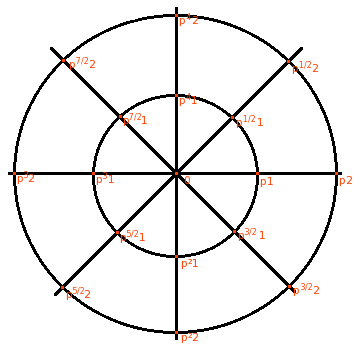Abdul Fattah
a.k.a. steve
- Messages
- 1,931
- Reaction score
- 450
- Gender
- Male
- Religion
- Islam
No offence, but this shows me that you still don't get it.What I was trying to say is that your system using all numbers but integer ones looks exactly the same as classical math:
A negative number multiplied by itself becomes positive
(-|2|)² = 4
A negative number multiplied by itself does not become positive. A negative number multiplied by itself is still a negative number.
ma*ma=m²a²
What you did (-|2|)² is not squaring a negative number, it's squaring the sum of [zero minus a neutral number]. In other words: (-|2|)≠m2
Also the thing that I'm trying to say, is the reason that things are similar, is because all the other axioms are the same. Similarity doesn't mean equality though, because there are different axioms.
First of all, wikipedia is off here. This is not by definition one of the criteria for real numbers, this is merely a description of them. Secondly the argument is circular; the description, and why it doesn't fit the alternative math is a direct result of the classical axiom |a|=+aCan both natural numbers and your integer numbers be represented on the same line?
It's a bit unfair to say that what I'm talking about is "unreal" simply because it doesn't follow the classical set or real numbers.
I would disagree, I would think they are existent in every real life problem, however since the end result remains the same when we ignore it, we aren't pointed towards their existence unless when dealing with square roots. See that's the major difference between p/m vs. i/-i. In the p/m paradigm, they are just a part of normal math, they are business as usual. The exception however lies with i/-i. Imaginary numbers from classical math, those are the ones that as you've put it: are not used in any real life problem except when dealing with square roots of negative numbers.The other thing I'm trying to say is that integer and mixed numbers are not used in any real life problem except when dealing with square roots of negative numbers.
Again I would disagree, but I can't argue against opinionsI honestly don't think pa and ma are a part of nature, reality, so no real life data would include them.
That's an interesting question you posed, and in a way it says allot about your line of thinking. First of all, your question implies that p and m can only exist if they are the result of something. Can you show me that the number 1 is the result of something? Can you show me that an equation sign (=) is the result of something? You might think that you can, but trust me on this one, you can't even show that equation is a real existing concept without first making assumptions. These symbols represent concepts, not side effects. Their existence is self evident, and in a way also axiomatic. Anyway, since you asked for a concrete example, i'll give it a try. But bear with me for a while first, so that I can make a point first.Show me a real life problem where ma or pa are a result of a measurement or a geometrical calculation or anything but square rooting a negative number.
Can you show a real life problem or a measurement or a geometrical calculation that negative numbers exist? Have you ever seen -4 ducks swimming in a pond? Have you ever measured a piece of wood to be -6.3cm? Well I guess you get my point here; negativity represents a concept. The best example we can think of bookkeeping. You can own 4€, or you could own a debt (=owe) of 4€. If you own 4€, that means [you have +4€] if you own a debt of 4€, then that means [you have -4€]. That is the only way where negativity as number makes sense, when it is an arbitrary number representing not what is there, but what is supposed to be there, or as what would be subtracted if there was something there to subtract from. Now think about the classical math axiom: |a|=+a; |a|≠-a.
How does it make sense, that the abstract quantity of |4|€, which is neither owned nor owed could be considered equal to a credit, but at the same time not equal to a debit. I mean, doesn't the fact that somebody owns it add a value to the abstract amount? Or even better, if someone owns it, it is no longer abstract, but represents an existing entity, in this case an existing sum of money. So if abstract number=existing owned entity, then why not make the same conclusion and say: abstract number=existing owed entity. What does credit have that debit does not have? The answer of course obviously is that this was chosen by axiom. And in a way I think that this should have answered your question by now.
How does it make sense, that the abstract quantity of |4|€, which is neither owned nor owed could be considered equal to a credit, but at the same time not equal to a debit. I mean, doesn't the fact that somebody owns it add a value to the abstract amount? Or even better, if someone owns it, it is no longer abstract, but represents an existing entity, in this case an existing sum of money. So if abstract number=existing owned entity, then why not make the same conclusion and say: abstract number=existing owed entity. What does credit have that debit does not have? The answer of course obviously is that this was chosen by axiom. And in a way I think that this should have answered your question by now.
That depend on your interpretation of integers and mixed. You see them as unreal, but as I told you I disagree. So I would disagree with follow to.And as I said, I believe you'd have to change the definition of real numbers in order to fit integer and mixed numbers into it. The same goes for rational and irrational numbers.
Well that's the baseline axiom. Ever since I've thought of this possibility, I can't shake the thought that this is actually more realistic. Because I think they actually are a separate set. For the same reason that kilograms to meters are considered separate sets and you can't add them up with each other. Because natural numbers represent something different then integer numbers. Because natural relates to integer in the same way that abstract values relates to existing debit and credit.If it's simply negativity and positivity, why can't you add or subtract integers and natural numbers. Why do integers have to be a separate set?
Are you asking me the cause or the reason I picked the axiom?If it's simply negativity and positivity, why can't you add or subtract integers and natural numbers. Why do integers have to be a separate set?
The cause is the axiom:|1| ≠ p1
As for why I believe that axiom to make sense, I could just as well reflect the question back, why do you hold the classical axiom to make sense?
Did you mean:And why do all other numbers work according to classical math axiom about negativity and positivity?
*Why do all other numbers work; according to classical math axiom about negativity and positivity?
Why wouldn't they work? Picking the wrong axiom doesn't mean your theory will fail, it simply means it no longer refers to reality. So if the classical axiom is unrealistic, then the numbers should still work despite of that. At least that is to say, that even with unrealistic axioms, the theory will bring results which lies within the expectations build by that axiom. There's no reason for the numbers to stop working despite of doggy axioms. It's very simple, both classical as well as alternative theory hold. Both rely on a different axiom. Only one of those two axioms can be realistic, hence math based on unrealistic axioms still makes perfect sense. It would probably have to use unrealistic numbers somewhere along the line though ^_^
*Why do all other numbers work -according to classical math axiom- about negativity and positivity?
Well in the classical math, positive is the default. So you cannot have a number that doesn't have a value. It is either always positive or else it's negative. A neutral (neutral in terms of neg/pos) number simply doesn't exist.
Last edited:

